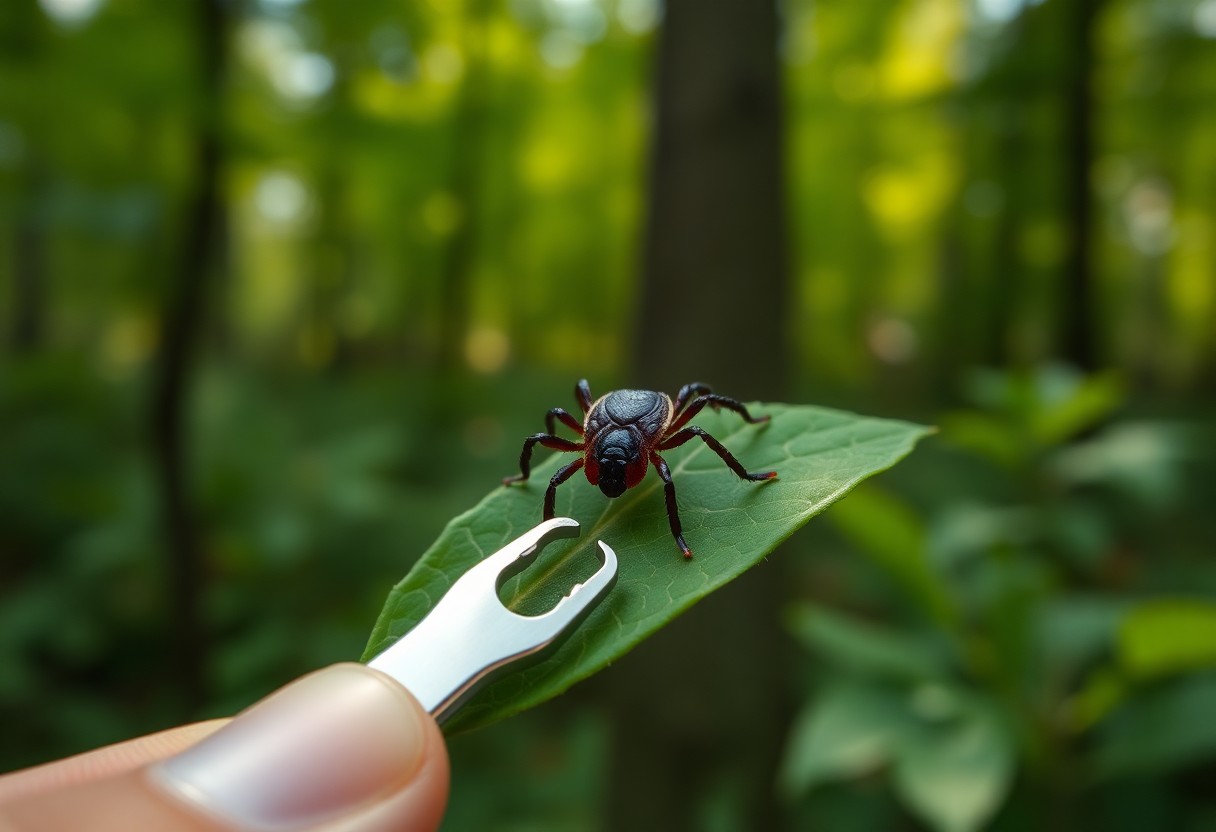Treatment for tick bites begins with understanding how to identify and prevent these small but potentially dangerous pests. In Mid Michigan, ticks are common and can carry serious diseases. By recognizing the different types of ticks you might encounter, you can better protect yourself and your family. This guide will provide you with practical steps to spot ticks early, prevent bites, and know what to do if you find one on your skin, helping you stay safe during outdoor activities.

Key Takeaways:
- Mid Michigan is home to several common tick species, including the Blacklegged (deer) tick, American dog tick, and Lone Star tick, each with distinct identification features.
- Preventing tick bites involves using repellents, wearing protective clothing, and performing regular tick checks after outdoor activities.
- Early detection and prompt removal of ticks reduce the risk of tick-borne illnesses; seek medical advice if symptoms such as rash or fever develop after a tick bite.
The Varieties of Ticks in Mid Michigan
Exploring the different types of ticks you’ll encounter in Mid Michigan reveals a fascinating yet concerning diversity. The region hosts several species, each with unique behaviors, habitats, and risks to your health. Understanding these varieties will sharpen your ability to identify ticks and respond appropriately after an encounter.
Mid Michigan’s tick populations primarily divide into two main groups: hard ticks and soft ticks. Both have distinctive characteristics that influence how they feed and interact with their environment. Additionally, emerging tick species in the area signify changing ecological patterns, making vigilance all the more necessary.
Hard Ticks: The Unwelcome Hosts
Hard ticks, scientifically known as Ixodidae, are the most commonly encountered ticks in Mid Michigan. Species like the Blacklegged tick (Ixodes scapularis) are notorious for transmitting Lyme disease and often attach firmly for days while feeding. These hard-bodied ticks carry a visible scutum, or shield, that gives their carapace a tough, smooth appearance.
American dog ticks (Dermacentor variabilis) and Lone Star ticks (Amblyomma americanum) also fall under this category. You might notice the Lone Star tick by the distinctive white spot on the female’s back. Hard ticks often quest for hosts from tall grasses or shrubs, so you can come into contact with them during outdoor activities, especially in wooded or brushy areas.
Soft Ticks: The Less Known but Still Dangerous
Soft ticks, belonging to the family Argasidae, differ significantly in appearance and behavior from hard ticks; their bodies lack the hard scutum and appear more leathery or wrinkled. You’re less likely to encounter soft ticks because they usually inhabit animal nests or burrows rather than questing openly in vegetation.
Despite their elusive nature, soft ticks like Ornithodoros species can transmit relapsing fever bacteria to humans. Their feeding sessions are also shorter—often just minutes—but repeated bites can cause serious discomfort or infections. You might underestimate the health hazard posed by soft ticks due to their less aggressive host-seeking behavior.
Soft ticks’ preference for hidden habitats means you especially need to consider them if you’re spending time in abandoned cabins or rustic animal shelters, places where these ticks commonly reside.
Emerging Species: What to Watch For
Changing climates and animal migration patterns have allowed new tick species to establish themselves in Mid Michigan. For example, the Gulf Coast tick (Amblyomma maculatum), once confined to southern states, has been detected in northern parts due to warming temperatures and shifting habitats. This species can carry pathogens responsible for rickettsial infections.
You may also encounter the invasive Asian longhorned tick (Haemaphysalis longicornis), first reported in the U.S. in recent years and now spreading in the Midwest. Though its disease-transmission potential in humans remains under study, this tick’s ability to reproduce rapidly in large numbers raises concerns about increased tick-borne illness risks.
Awareness of these emerging species can help you adjust personal protective measures and keep your outdoor activities safer. Tracking their spread and understanding their biology remain priorities for public health officials in your area.
Identifying Ticks: Key Characteristics and Markers
Recognizing ticks on your person or pets involves focusing on specific traits that differentiate species and life stages. Observing their physical markers like size, shape, color, and developmental stage allows you to better understand the risks they pose and how to respond appropriately. Each tick species common in Mid Michigan carries distinctive features which can alert you to potential risks such as Lyme disease or other tick-borne illnesses. You’ll find that even subtle differences in markings or body proportions can guide you toward accurate identification.
Ticks are often mistaken for tiny dots on clothing or skin, but getting familiar with their characteristics will help you respond quickly. At a glance, size matters when deciding if what you’re seeing is a tick or just specks of dirt or debris. Comparing their shapes against known species profiles assists in distinguishing the various ticks active in this region.
Size and Shape: What to Measure
The size of ticks varies widely from larvae to adult stages. Larvae measure roughly 0.5 millimeters and look almost translucent, while adults can range from about 3 to 5 millimeters in length before feeding. Engorged females swell significantly, sometimes growing up to 10 millimeters or more after feeding, changing their outline from flat to rounded. If you spot a tick on your skin or in your yard, using a ruler or a measuring reference can help you determine its stage and urgency.
Beyond size, shape differences among species deserve your attention. The Blacklegged tick (Ixodes scapularis) has a more oval, compact body compared to the American dog tick (Dermacentor variabilis), which tends to have a broader, shield-like scutum covering its back. You can examine the overall body shape with a 10x magnification to spot these subtle differences. Being mindful of these details will assist you when inspecting yourself after outdoor activities.
Color and Patterns: Distinguishing Features
Ticks exhibit a range of colors and patterning that provide visible clues to their identity. The Lone Star tick (Amblyomma americanum), for example, displays a distinctive single white spot on the female’s dark brown back, which gives this species its name. Blacklegged ticks generally have a darker, almost black body with a reddish-orange area behind the head shield. Meanwhile, the American dog tick is mottled with whitish or gray markings across its hard shield, making it stand out against the darker legs and body.
These color markers become more pronounced under sunlight or artificial light, so examining ticks with good lighting enhances your ability to spot their signature traits. You’ll want to actively look for these patterns when removing ticks, as early identification can inform your next steps in treatment and prevention.
In addition, seasonal variations and feeding stages affect coloration. Unfed ticks maintain vibrant patterns that can fade once they begin to engorge on blood. Recognizing the baseline color and patterns helps differentiate species even after they have attached and started feeding.
Life Stages: Recognizing Nymphs and Larvae
Ticks progress through three main life stages—larva, nymph, and adult—each presenting distinct challenges for detection. You might overlook larvae as they are about the size of a grain of sand and possess only six legs, compared to nymphs and adults which have eight. Nymphs, slightly larger at approximately 1 to 2 millimeters, often go unnoticed because of their small size and translucent bodies but pose a significant role in disease transmission in Mid Michigan.
The size differences in these life stages mimic changes in appearance, but the number of legs and relative body proportions offer reliable clues. Specifically, the nymph stage has eight legs but lacks some of the hardened shield features seen in adults. You can spot subtle shifts in the tick’s abdomen, which tends to be softer and less rigid in nymphs and larvae.
Larvae and nymphs are especially problematic because their tiny size allows them to evade your attention more easily during tick checks. Annual studies of tick populations in Mid Michigan confirm that nymphal Blacklegged ticks carry the highest infection rates of Lyme disease, demanding particular scrutiny when examining yourself or your pets after outdoor exposure.
Where Ticks Live: Favorite Habitats in Mid Michigan
Ticks thrive in environments that provide ample shade, moisture, and access to hosts like deer, rodents, and birds. In Mid Michigan, their populations concentrate in areas where these conditions consistently overlap. Understanding where ticks congregate helps you take targeted precautions and reduces the chances of an encounter during outdoor activities. From shady woodlands to surprising urban nooks, their habitats are more diverse than you might expect.
While many associate ticks exclusively with natural landscapes, they have also adapted to environments altered by humans, making awareness in both rural and suburban areas crucial. Knowing the micro-environments ticks favor assists you in choosing proper clothing, repellents, and inspection routines after exploring various settings.
Woodlands and Overgrown Areas: Nature’s Tick Hotspots
Dense woodlands and overgrown fields offer an ideal setting for ticks to flourish. The shaded canopy maintains humidity levels that keep ticks from drying out, while leaf litter and tall grasses provide perfect questing platforms. Mid Michigan’s mixed hardwood forests, especially in counties like Clare and Isabella, harbor significant Blacklegged tick populations, responsible for spreading Lyme disease. You’ll find ticks commonly positioned on the edges of trails where they wait to latch onto passing hosts.
Brushy areas adjacent to water sources such as streams and marshes serve as additional prime habitats. Here, small mammals like white-footed mice abound, acting as key hosts in the tick lifecycle. The combination of animal activity and favorable microclimates makes these overgrown zones consistent hotspots for tick encounters throughout spring and summer.
Urban Environments: Surprising Tick Locations
Areas you may not suspect, like city parks, suburban backyards, and community gardens in Mid Michigan, can support tick populations. Fragmented green spaces with brush piles and unmanaged shrubbery provide suitable conditions for ticks to survive and reproduce. With deer increasingly adapting to suburban landscapes, you might find ticks closer to home than expected, lurking along garden edges, under decks, or even in tall grass bordering sidewalks.
Pets that spend time outdoors in these urban-adjacent spaces can carry ticks inside, inadvertently introducing them into your living area. Cases of Lone Star ticks, known for their aggressive behavior and expanding range, have been documented in residential zones around Midland and Mount Pleasant. Awareness of these urban tick enclaves helps you stay vigilant even in settings you consider less “wild.”
Maintaining vegetation, avoiding brushy patches near homes, and checking yourself and your pets after yard work or walks in local parks can drastically reduce your tick exposure in these surprisingly tick-friendly urban environments.
Seasonal Changes: When and Where to Be Wary
Tick activity in Mid Michigan follows distinct seasonal patterns influenced by temperature and humidity. You’ll notice nymph stages, which pose the highest risk for Lyme transmission due to their small size, becoming most active from late spring through mid-summer. Early fall ushers in adult ticks ready to feed before winter dormancy, extending the risk period into October. Periods of warm, moist weather often trigger surges in questing behavior.
During winter’s coldest months, tick activity plummets, but sporadic warm spells can prompt brief re-emergence. You’re more likely to encounter ticks in densely shaded areas or leaf litter during transitional seasons when microclimates preserve moisture. Monitoring seasonal trends can help you plan outdoor excursions and tailor your tick prevention strategies accordingly.
Detailed tick surveillance data from Mid Michigan’s Department of Natural Resources show peak nymph activity consistently occurs between May and July, with a secondary adult activity peak in September and early October. Adjusting your awareness and checks to these windows maximizes protection against potential tick-borne illness.
Protective Measures: Keeping Yourself Tick-Free
Adopting proactive strategies can significantly reduce your chances of encountering ticks during outdoor activities. Understanding how to shield yourself not only prevents bites but also minimizes the risk of contracting tick-borne diseases. Combining proper clothing choices, smart outdoor habits, and maintaining your yard effectively creates multiple layers of defense against ticks.
Regularly performing thorough tick checks on your body and gear after spending time outdoors improves early detection. Removing ticks promptly, ideally within 24 hours, can drastically lower the odds of pathogen transmission. Using repellents containing DEET, picaridin, or permethrin-treated clothing further enhances your protection in tick-prone environments.
Clothing and Gear: Best Practices for Tick Prevention
Wearing light-colored clothing helps you spot ticks more easily before they latch on. Tucking pants into socks or boots creates fewer openings for ticks to crawl under your clothing. Opting for long-sleeved shirts and sealing cuffs tightly minimizes exposed skin, which ticks seek for attachment.
Permethrin-treated clothing offers a chemical barrier that repels and kills ticks on contact. You can purchase pre-treated gear or apply permethrin spray yourself to shoes, pants, and hats. Combine that with using insect repellents on exposed skin to maximize the effectiveness of your protective ensemble.
Outdoor Strategies: How to Safely Enjoy Nature
Staying on designated trails keeps you away from dense underbrush and wooded edges where ticks thrive. Avoiding tall grasses and leaf litter reduces the possibility of encountering questing ticks waiting to latch onto a host. Planning outdoor activities during mid-day, rather than dawn or dusk, can also help, since ticks tend to be more active during cooler, shaded periods.
When camping or picnicking, setting up tents and seating areas on cleared, sunny grounds lessens tick exposure. Keeping pets on a leash and checking their fur regularly prevents ticks from hitching a ride into your home. Carrying a small brush or lint roller aids in removing any ticks before they embed themselves.
Additional caution in natural areas includes avoiding sitting directly on logs or rocks, which often harbor ticks. Carrying a mirror or using your phone camera helps inspect hard-to-see areas like behind ears, scalp, and under arms immediately after outdoor sessions.
Yard Maintenance: Making Your Home Less Tick-Friendly
Clearing leaf litter, tall grass, and brush around your home reduces tick habitat and limits their proximity to your living spaces. Maintaining a well-mowed lawn and removing piles of wood or debris minimizes places where ticks and their hosts—like rodents and deer—can hide. Creating a 3-foot wide barrier of wood chips or gravel between wooded areas and your yard helps discourage tick migration into recreational areas.
Consider using landscape fabric or commercial tick control products containing acaricides applied periodically in shaded, moist zones that favor tick breeding. Incorporating native plants that repel ticks or attract tick-eating predators can form part of an integrated management approach. Consistent yard maintenance combined with these tactics lowers the number of ticks around your home significantly.
Engaging professional pest control services for seasonal treatments offers an added layer of security, especially if you live near forested regions with high tick populations. Combining these yard-focused strategies with personal protective measures creates a comprehensive approach to keeping your family safer season after season.

Tick-Related Health Risks: The Bigger Picture
Ticks in Mid Michigan carry more than just a nuisance factor—they pose significant health risks that can impact your well-being well beyond the initial bite. The Blacklegged tick, for example, is notorious for transmitting Lyme disease, which affects over 300,000 Americans annually. Aside from Lyme disease, several other infections like Anaplasmosis, Babesiosis, and Powassan virus also circulate through tick populations here. While the American dog tick primarily transmits Rocky Mountain spotted fever, the Lone Star tick has been linked with ehrlichiosis and even allergic reactions such as alpha-gal syndrome, a red meat allergy. Being aware of these varied pathogens expands your understanding of the risks associated with each tick encounter.
You often don’t notice a tick bite immediately because of the tick’s small size—an adult Blacklegged tick, for instance, measures less than 1/8 inch before feeding. This stealth can delay you from assessing potential health problems linked to these bites. Moreover, weather patterns that extend tick activity seasons increase your chances of exposure. Late spring through fall presents the sharpest window for tick encounters in Mid Michigan, which means vigilance during this period will better protect you and your family.
Identifying Tick-Borne Diseases: What You Should Know
Lyme disease remains the most common tick-borne illness in Mid Michigan, caused by the bacteria Borrelia burgdorferi carried by the Blacklegged tick. You might recognize the signature “bull’s-eye” rash appearing at the bite site in up to 80% of cases, yet some infected individuals never develop this rash. Knowing that Lyme disease can progress to affect joints, the heart, and the nervous system highlights why early diagnosis is paramount.
Besides Lyme disease, Anaplasmosis and Babesiosis, transmitted by the same tick species, present overlapping symptoms but require distinct treatments. Babesiosis often targets red blood cells causing fatigue and hemolytic anemia, which can be severe in people with weakened immune systems. Meanwhile, Powassan virus, though less common, can trigger serious neurological symptoms such as encephalitis in under two weeks after infection. Understanding the diversity in tick-borne diseases helps you communicate effectively with healthcare providers and advocate for prompt testing.
Symptoms to Watch For: Early Detection Matters
Fever, chills, headache, fatigue, and muscle aches often surface as initial hints that something is wrong after a tick bite. While these symptoms may seem flu-like, observing a rash—especially the expanding erythema migrans rash—should raise red flags for Lyme disease. Tenderness and swelling in joints typically follow if treatment is delayed, signaling disease progression. Some people also experience neck stiffness or facial palsy in the later stages.
You might notice symptoms emerging days to weeks after a bite, so maintaining awareness is key. Particular attention should be paid to any unexplained neurological symptoms, such as numbness or weakness, which could indicate the infection has spread systemically. Tracking changes and reporting them to your healthcare provider allows for timely intervention.
Developing a personal checklist following outdoor activities, including monitoring your body for skin changes or systemic signs, can help you identify concerns early. The sooner you act on these symptoms, the better the outcomes with most tick-borne illnesses.
Long-Term Effects: Understanding Chronic Conditions
Some individuals experience prolonged symptoms after treatment of tick-borne diseases, a phenomenon often referred to as Post-Treatment Lyme Disease Syndrome (PTLDS). Persistent fatigue, cognitive difficulties such as memory problems, and joint pain lasting for months highlight the chronic nature of these illnesses. In certain cases, inflammation induced by the infection can damage tissues leading to longer-term disability if left unchecked.
Other tick-borne diseases may also harbor surprisingly lasting impacts. Babesiosis, for instance, can cause anemia that requires ongoing management in severe cases, while Powassan virus infection may lead to permanent neurological deficits such as motor dysfunction. Rehabilitation and supportive care become important components of managing these sequelae, underscoring the importance of preventing infection outright.
Tracking your recovery and consulting specialists, such as infectious disease experts or neurologists, will provide the best guidance if symptoms linger. Advocating for your health through informed conversations ensures you get comprehensive care tailored to chronic tick-related conditions.
Final Words
Following this overview of ticks in Mid Michigan, you are now better equipped to identify the most common types you may encounter and understand the steps necessary to protect yourself and your loved ones. Awareness of tick species such as the blacklegged tick, American dog tick, and lone star tick enables you to recognize their presence and anticipate potential risks associated with each. By taking preventive measures like using insect repellent, wearing appropriate clothing, and performing regular tick checks after spending time outdoors, you can significantly reduce your chances of tick bites.
In case you do find a tick attached, prompt and proper removal is crucial to minimize the risk of infection. You should also stay alert for any symptoms following a tick bite and seek medical advice when needed. With the right knowledge and precautionary actions, you can confidently enjoy the natural beauty of Mid Michigan while keeping ticks and the illnesses they may carry under control.

